People and Organizations
| Aguinaldo, Emilio |
MacArthur, Arthur |
| Bell, Franklin |
Malvar, Miguel |
| Chaffee, Adna |
McKinley, William |
| Dewey, George |
Otis, Elwell S. |
| Funston, Frederick |
Partido Federal |
| Guerrilla Fighters |
Peoples of the Philippines |
| Imperialists and Anti-Imperialists |
Rizal, José |
| Katipunan |
Roosevelt, Theodore |
| Lawton, Henry |
Smith, Jacob |
| Lukban, Vincente |
Taft, William |
| Luna, Antonio |
Taft Commission |
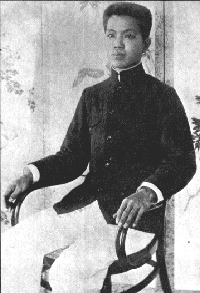
Philippine Independence Leader
Emilio Aguinaldo was born March 22, 1869, in Kawit, in the province of Cavite, Luzon. Half Chinese, he enjoyed relative wealth and power and became mayor of Kawit in 1895. After Rizal's execution in 1896, Aguinaldo joined the Katipunan, a secret society opposing Spanish rule, and quickly came into conflict with its leader, Andres Bonifacio. Aguinaldo soon gained control of the society and had Bonifacio arrested for treason and executed. He then led a rebellion against the Spanish, which ended with the Biak-na-Bato pact December 14, 1897. As part of this agreement, Aguinaldo and 34 of his followers left for Hong Kong, where he stayed until May of 1898. Upon his return, Aguinaldo immediately resumed revolutionary activities against the Spaniards, under the encouragement of the United States. The revolution was a success, and on June 12, 1898, the Philippines, with Aguinaldo as leader, declared themselves independent from Spain. He was elected president on January 29, 1899. However, tensions between the Filipinos and the Americans mounted, and on February 4th, 1899, war broke out between them. Aguinaldo led the Filipino resistance against the Americans, and was president and primary Filipino general throughout the war. Filipino support for Aguinaldo was widespread, and he was rumored to have a spiritual force which protected him from knifes and bullets. Aguinaldo was captured by American General Frederick Funston in 1901. After three weeks as a prisoner, he took an oath of allegiance to the U.S. on April 19, 1901, and issued a proclamation urging the surrender of all Filipino forces. He died on February 6th, 1964, having lived to see the Philippines free.

Born in 1856, Franklin J Bell graduated from West Point Military Academy in 1878. He went on to fight as a cavalry officer in many Indian campaigns. He later served under General MacArthur in central Luzon, and was awarded a congressional medal of honor for bravery in battle. In February 1901, Bell was made a brigadier general and was put in charge of the 1st District of Northern Luzon, where he began his “zone” policy, which led to the surrender of the guerrillas by May 1901. On account of his success in N. Luzon, he was reappointed on November 30, 1901 to the 1st District of S. Luzon, which included the province of Batangas. Here, Bell ordered the forced relocation of almost the entire civilian population into selected towns which served as prison camps, freeing him to destroy everything outside the "zones.” After the war, Bell was criticized for his actions, but became the head of the Infantry and Calvary School at Fort Leavenworth, Kansas. From April 1906 to April 1910, he served the Chief of Staff of the U.S. Army. Franklin Bell died a hero in 1919."It is an inevitable consequence of war
that the innocent must generally suffer with the guilty.”--Bell, Batangas campaign
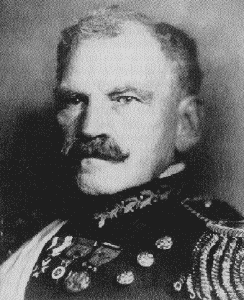
Adna Romanza Chaffee was born in Ohio in 1842. A veteran of the Civil war and countless Indian campaigns, he served throughout the Spanish-American War, and commanded American troops in the capture of Peking, China, during the Boxer rebellion. He replaced MacArthur as head general of the Philippines on July 4, 1901. Chaffee was the “soldier’s soldier,” a tough, hard-riding cavalryman who despised civilians in general and intended to crush the “insurrection.” He appointed Gen. Bell to Batangas and Smith to Samar, with orders to do whatever was necessary to destroy the opposition--he wanted an Indian-style campaign instead of the previous “humanitarian warfare.” Chaffee’s orders were largely responsible for the atrocities that marked the later stages of the war. When the war ended in 1902, Chaffee returned to the States, where he served as lieutenant general and Chief of Staff for the U.S. Army from 1904-1906. He retired in 1906 and died in 1914."If you should hear of a few Filipinos more or less being put away don't grow too sentimental over it."--Chaffee, to newspaper correspondent Joseph Ohl
George Dewey
George Dewey was born in 1837 in Montpelier, Vermont. He graduated from Annapolis in 1858 and then served in the Civil War. In Jan of 1898, he became the commander of the Asiatic Squadron and sailed to Hong Kong. There he waited until he received word that war had broken out between the U.S. and Spain. He then sailed to Manila and destroyed the Spanish fleet in the Battle of Manila Bay. He encouraged Aguinaldo to liberate the Philippines from the Spanish and gave Aguinaldo the impression that the U.S. was in favor of Philippine independence. When American troops arrived he turned on Aguinaldo and used his artillery to drive the Filipinos from Manila on February 5, 1899. He was promoted to admiral for his actions in the Philippines. In the fall of 1899 he returned to the U.S. where he served the U.S. Navy Dept. until his death in 1917.
"In my opinion these people are superior in intelligence and more capable of self-government than the natives of Cuba, and I am familiar with both races--Of course, he soon changed his mind.
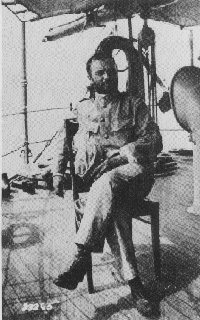
Frederick Funston was born in Kansas in 1865. His father was a six-foot-two, two hundred pound Civil War hero, but “Little Colonel Funston” was always unusually small. As an adult, Funston was five feet five inches and weighed 115 pounds. He was teased for his stature, and resolved to make up for size with military heroics. However, Funston was rejected by West Point for poor grades. In 1886, he went to the University of Kansas, but eventually dropped out. Funston went on to explore remote parts of Death Valley and northern Alaska, before being offered a commission as an artillery officer in the Cuban army in 1895. After suffering several serious injuries, attempting to sneak back to the U.S., and being court martialled for his actions, Funston was given command of the 20th Kansas Regiment when America entered the war in 1898. However, his regiment was sent not to Cuba, but to the Philippines, where Funston finally found the heroics and publicity he was seeking. In spring of 1901, Funston’s men captured a Filipino courier carrying dispatches from Aguinaldo. From the messenger, Funston learned the location of the Filipino leader's secret headquarters, and his daring but deceitful capture of Aguinaldo was the final blow to the insurrecto army. For his actions in the islands, Funston was promoted to brigadier general, the youngest in the army. However, he soon faded from public attention, and died of a heart attack in 1917, at the age of fifty-one."I, for one, hope that Uncle Sam will apply the chastening rod, good, hard, and plenty, and lay it on until they come into the reservation and promise to be good "Injuns."
--Colonel Funston, 20th Kansas Volunteers
By the beginning of 1901, the Filipino military organization had shattered under the pressure of American opposition, and the army was scattered and disorganized. Aguinaldo soon realized the futility of waging conventional war against the Americans in this position, and reorganized his army into small bands of guerrilla warriors. Power was given to local commanders, and towns were abandoned in favor of the jungle. Filipino villages pretended to cooperate with American troops. Instead of attacking outright, the Filipino warriors began sabotaging telegraph lines and supply wagons and ambushing pursuing parties. After an attack, the guerrillas could quickly hide their weapons and pose as friendly civilians. They struck by surprise in small numbers, and quickly vanished into the brush. This strategy was particularly evident in southern Luzon, especially Batangas, where General Malvar commanded the guerrilla troops. Combating the guerrillas left American troops weary and frustrated, and they increasingly viewed the Filipinos as treacherous savages. The Filipinos believed that the Americans would soon grow tired of this war and leave, or that anti-imperialist William Jennings Bryan would be elected president. However, McKinley was reelected, and even this guerrilla strategy did not prove a great success; the Filipinos still lost far more soldiers than the Americans.
On December 10, 1898, the Paris Peace Treaty which ended the Spanish American War was submitted to the Senate for ratification. The treaty gave Americans control of the Philippines, and the debate over ratification in the Senate reflected the deep division of popular sentiment in the United States. On one side were the imperialist, ardent supporters of annexation. They believed that acquiring new territory would revitalize the nation, allowing it to expand economically into Asia, and some felt that it was the “white man’s burden” to care for the Filipinos and bring Christianity to the islands (never mind that the Filipinos were already Catholic).
The anti-imperialist were a minority, but a very distinguished one. Grover Cleveland, Samuel Gompers, Mark Twain, and William Jennings Bryan were just a few. Like the imperialists, their reasons for opposing annexation were varied. Some were downright racists who felt that the Philippine “niggers” would only hurt the United States. Others pointed out that America could hardly hope to stand for freedom and democracy while enslaving the far off territory of the Philippines. To combat the imperialists, the Anti-Imperialist League was formed in Boston in November of 1898 (Platform of the Anti-Imperialist League). This league of mainly upper class easterners claimed 70,000 members within a year. Unfortunately, it wasn’t enough to change the opinions of the majority of Americans.
Twain served as Vice President of the league from 1901 until his death in 1910. He authored many satirical protests against the war, including "To the Person Sitting in Darkness."
"And as for a flag for the Philippine Province, it is easily managed. We can have a special one -- our States do it: we can have just our usual flag, with the white stripes painted black and the stars replaced by the skull and cross-bones."
--From "To the Person Sitting in Darkness"
On February 6, 1899, the Senate ratified the Paris Peace Treaty, after receiving a boost from Bryan, who although an anti-imperialist, argued that ratification of the treaty didn’t necessarily mean that the U.S. would remain in possession of the islands. He proposed that the issue would be decided in the next presidential election of 1900 in which he would challenge McKinley. Bryan was certain that the majority would be opposed to annexation and elect him. However, his advocacy of “free silver” eclipsed the issue of imperialism and may have cost Bryan the election and the Philippines their freedom.
The Katipunan was a secret Filipino organization, perhaps made up of 20-30 thousand Filipinos, created to resist Spanish rule. The group was originally headed by Andres Bonifacio, who was later executed by Aguinaldo. The Katipunan revolted in 1896 after the execution of Rizal. The revolution ended in 1897 and in 1898 it was disbanded. Aguinaldo later revived the organization in 1901 to help support his guerrilla forces.
Henry Ware Lawton was born in Ohio in 1843. He served in the Union Army in the Civil War, and was awarded a medal of honor for heroism at Atlanta. He entered the regular army in 1867, and served in Indian frontier fighting. Lawton was the commander who captured Geronimo in 1886. He became a major general of volunteers in Cuba during the Spanish-American War, and went to the Philippines in 1899. Lawton was far less obsessed with media image than most of his peers, and was an effective commander. Lawton was known as honest and quick to praise the courage of others, and was widely admired by troops and reporters alike. His habit of parading just behind the forward firing line became his downfall on December 18, 1899, when he was killed in a minor skirmish outside Manila against General Lucerio Geronimo and 250 Filipino riflemen.
General Vincente Lukban was probably one of the more ruthless commanders on either side of the Philippine conflict. On December 31, 1899, he gathered 100 Filipino riflemen and proclaimed himself the new governor of Samar under the Philippine Republic, meeting little resistance. When the 1st United States Infantry landed on Samar’s shores in January 1901, they were met by charges of suicidal bolomen under Lukban’s command. Lukban was soon forced to retreat inward, leaving behind an organized resistance network. Samarenos caught cooperating with the Americans were executed swiftly and dramatically. When MacArthur offered Lukban amnesty in exchange for his surrender, he turned it down and swore to fight to the end. It was Lukban who masterminded the surprise attack in Balangiga, the “Balangiga Massacre.” Lukban was captured by American forces on February 27, 1902.
General Antonio Luna was appointed Director of War by Aguinaldo in September of 1898. He was the primary Filipino field commander in the early stages of the war. Luna was an aggressive and effective leader, utterly inflexible in seeking independence. He was a better military commander than Aguinaldo, better educated, and of higher social status, and the competition between then became intense. His refusal to retreat and follow Aguinaldo’s orders resulted in the loss at the Battle of Calumpit on April 24, 1899. In June of 1899, Luna was assassinated by Cavite soldiers loyal to Aguinaldo.
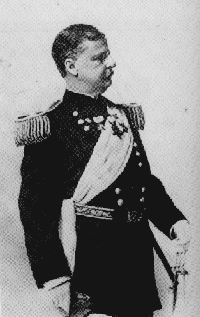
Arthur MacArthur was born in 1845. He served in the Civil War, where he earned a Congressional Medal of Honor for heroism in battle. From 1898-1899, he was a major general of volunteers in the Spanish-American War. On May 2, 1900, MacArthur replaced Otis as Military Governor of the Philippines. His view of the war was far more realistic than Otis’, and he realized the time and energy it would take to conquer the islands. He censored the press as much as Otis did, and exported those unwilling to comply. MacArthur started an Amnesty program, offering freedom and pardon to Filipino generals in exchange for their surrender. The highlight of MacArthur’s command was the capture of Aguinaldo in 1901. On July 4, 1901, MacArthur transferred his responsibility as governor to Taft and general to Adna Chaffee. He then returned to the United States, and served as lieutenant general and assistant chief of staff in 1906. MacArthur retired in 1909, and died in 1912."No war in history has been conducted with as much humanity."--MacArthur, before Lodge Committee
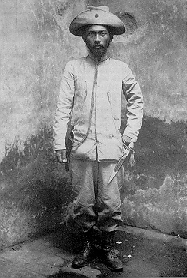
Miguel Malvar was born in 1865, in Santo Tomás, Batangas. His father was a wealthy logger and land owner able to finance Miguel’s education at Malaban School in Tanauan. Malvar married and became a wealthy orange farmer. He ran for the office of gobernadercillo in 1889 and lost, but he won in 1890. He fought beside Aguinaldo in 1896 and 1897, and went into exile to Hong Kong along with him. Malvar returned to Batangas, and after several months of peace joined in the war against the Americans at the head of the Batangueño resistance. He was a crafty, charismatic, and effective leader, and was very popular among the Filipino population. He led the Batangueño warriors in extended guerrilla warfare against the American troops, and often disguised himself as a civilian to escape capture. His reputation grew to legend, and it was believed he had magic powers and was impervious to bullets. He was one of the few true heroes of the war, above the petty bickering that seemed to characterize the Filipino chain of command. After Aguinaldo was captured, Malvar proclaimed himself commander of all “Liberating Forces” on July 13, 1901. On April 16, 1902, Malvar was forced to surrender. Malvar is remembered as the last Filipino general to surrender to the Americans. He then returned to farming and died in 1911. His four sons were educated in the United States.
Born in 1853 in Ohio, William McKinley served through the Civil War and practiced law. He was elected 26th president of the United States in 1896, and was responsible for the declaration of war against Spain and the decision to assimilate the Philippines. McKinley was reelected in 1900, but was assassinated by anarchist Leon Czolgosz and died on September 14, 1901. He was succeeded by Vice President Theodore Roosevelt.
Born in 1838, Elwell Otis served as a major general of volunteers in the American Civil War. From 1881-1885, he served as the first commandant of the School of Application for Cavalry and Infantry at Fort Leavenworth, Kansas, the school which now stands at the center of military education for the Army. On August 22, 1898, he arrived in the Philippines to replace Gen. Wesley Merritt and became the first Military Governor of the Philippines. He was held in almost universal contempt; by the Filipinos, with whom he refused to negotiate, by the soldiers, who called him a “silly old Grandmother,” and by the press, whom he continuously deceived about the war. His commanders routinely engaged in shouting matches with Otis in front of the troops, and disobeyed his orders with impunity. His arrogance and rude treatment of the Filipinos was one of the factors leading to the outbreak of war. When the war began, he failed to make much progress and was replaced by Arthur MacArthur on May 2, 1900. He then toured the United States, assuring everyone (as he had all along) that the war was over, even as MacArthur requested more troops. He retired a few years later, and died in 1909.
The Partido Federal was formed in late 1900 by former insurgent leaders who had given up hope for a Filipino victory and members of the powerful land holding class who saw opportunity in allying themselves with the Americans. The Partido Federal was official inaugurated on January 22, 1901 with the support of American Governor Taft. The support of the Americans went a long way in boosting party membership because most of the government jobs were given to party members. The Partido Federal’s platform called for local government for the Filipinos and eventual freedom, although at one point they wanted to become a state. After Taft left in 1904, the party lost its patron and many Filipinos came to view the Partido Federal as too American and supported more nationalistic parties.
The Macabebes were warlike natives to the island of Pampanga who harbored an intense dislike for Aguinaldo and the Tagalogs. They had served Spain, and when the Americans arrived they offered to serve them as well. At first, the Americans were reluctant to ally with natives, but the Macabebes proved themselves many times and played a key role in the capture of Aguinaldo. They were well known for their practices of rape, looting and murder. Over the course of the war, about 5,000 Macabebes were recruited, comprising 5-6% of the U.S. Army
-
The Moros occupied Mindanao and the other southern islands. They were made up of over ten ethnic groups, each led by a sultan who also held religious responsibilities. Muslims, they disliked their northern Christian neighbors and rejected Aguinaldo as their leader. At first, they accepted American rule on the promise that the Americans would interfere little in local affairs. However, a Moro attack on an American garrison led to a retaliatory force which terrorized the island of Mindanao, uniting the Moros against the United States. The Moros continued to fight past 1913.
-
The Tagalogs were the ethnic group inhabiting central Luzon. They were generally considered the ruling class and had their own distinct language. Aguinaldo was a Tagalog as were many of the resistance fighters on Luzon.
Dr. Jose Rizal inspired the Filipino revolution against the Spanish with his book Noli me Tangere, in which he protested the Spanish rule of the Philippines and the policies of the powerful friars. A pacifist, he became uncomfortable with the violent aspects of the revolution he had helped to create and in 1896 petitioned the Spanish government to allow him to help fight yellow fever in Cuba. The Spanish granted his request, but soon changed their mind and arrested Rizal in Barcelona. He was returned to the Philippines and executed for treason. His death made him a martyr and inspired the Katipunan to revolt.
"I die without seeing the sun rise on my country. You who are to see the dawn, welcome it, and do not forget those who fell during the night."
-From his book Noli Me Tangere.
Theodore “Teddy” Roosevelt was born in New York in 1858. He graduated from Harvard in 1880, and became involved in law and politics. He served as colonel of the Rough Riders in Cuba during the Spanish-American War. He was McKinley’s vice president and replaced him as president on September 14, 1901, after McKinley was assassinated. Roosevelt supported Chaffee’s tactics in the Philippines. Roosevelt was reelected in 1904, and is remembered for building the Panama canal and organizing the progressive Bull Moose party. He died in 1919.
"Hell Roaring Jake" Smith was a cavalry officer and veteran of many Indian campaigns. In the earlier part of the war, he served as a colonel under Gen. Bell in Batangas, and adopted brutal fighting techniques against the Filipino "savages." After the Balangiga Massacre, General Chaffee promoted Smith to brigadier general and put him in charge of the Samar campaign. In Samar, Smith earned fame with his orders to "kill everyone over the age of ten" and make the island "a howling wilderness." In May of 1902, Smith faced trial for his actions, and the court-martial found him guilty. He returned to the United States and was retired with no further punishment.
"I want no prisoners. I wish you to kill and burn, the more you kill and burn the better it will please me...Kill everyone over the age of ten."
--Gen. Jacob Smith, Samar campaign
Born in 1857, Taft graduated from law school and worked his way up from lawyer to U.S. circuit court judge. President McKinley made him head of a commission to the Philippines to bring peace and prosperity to the islands. He was appointed governor in 1901. He later became vice-president under Roosevelt and was the 27th president of the United States. As president, he lost support and only served only one term. He then fulfilled his dream to become a Supreme Court justice and died in 1930.
McKinley sent his first civilian commission to the Philippines in 1899, only to discover that war had broken out. He tried again in 1900 with a second commission headed by Taft. The commission arrived in June and began by surveying the situation on the islands by traveling around and interviewing Filipinos. During this time, Taft was highly optimistic that peace would prevail on the island, probably because the reports he was sending back to Washington were being used to by McKinley in his reelection campaign against William Jennings Bryan.
On September 1, the commission assumed the legislative duty to enact laws and controlled 2.5 million dollars that the military had collected on the islands so far. This money and taxes from Filipinos were used to modernize the islands with schools, roads, and sanitation facilities. Although Taft referred to the Filipinos as “little brown brothers” and thought they were morally and intellectually inferior to Americans, he nonetheless incorporated many of the upper class into his government. Taft was appointed governor of the islands in July 1901.
The Taft commission began the Americanization of the Philippines. The schools they built hired American teachers and classes were in English. Those who supported the Americans often benefitted immensely and even today, the Philippines maintain strong ties to America.
If you have any questions, comments, or information about the Philippine-American War, please email Kendra & Rebecca at avalay@yahoo.com.






